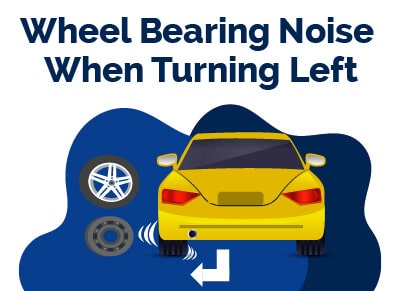Wheel Bearing Noise When Turning Left
September 21, 2022


I am a serial entrepreneur and a consumer advocate. When I’m not helping car buyers, I love working on ventures that have a positive impact.
I run a cause marketing agency and serve on the board of Vayu Global Health where we are disrupting the medical industry and preventing the needless deaths of mothers and babies during childbirth.
You figured out that your car is making weird noises when turning left, but you can’t determine what exactly is going on.
Hearing a howling or grinding noise when turning left is a sign that you have a bad right wheel bearing.
Let’s explain this in detail to help you understand how to diagnose a wheel bearing noise and why a wheel bearing noise when you turn left indicates that you have a bad right wheel bearing.
Table of Contents
Diagnosing Wheel Bearing Noises
Howling noise
A howling noise when turning left shows that your right wheel bearing has gone bad or is gradually failing.
This happens because when you turn your car to the left, the car’s weight and motion performance are thrown to the right wheel. If the right wheel bearing is bad, the wheel bearing noise will get louder when you turn left.
Squealing and Grinding Noise
Squealing or grinding noise when turning also can be a sign of a bad wheel bearing.
Exceptions
While it may seem like turning left will place a tremendous load on your right wheels, there are exceptions for Volkswagen Mark IVs.
The Volkswagen Mark IV features a double-row angular contact wheel bearing. This gives you a dual-set of ball bearings in a bearing shell. In this scenario, you have the inner and outermost bearings on the same, which we might tag the right and left.
So, when you turn left and notice some wheel bearing howling in your car, there are strong indications that the right wheel is gone, but it may just be that one of the sets went bad.
We won’t advise changing both wheel bearing sets, but you can take your inspection a bit higher than relying on the noise diagnosis.
Which Wheel Bearing Is Bad When Turning Left?
To discover which wheel bearing is bad when turning left, you have to take note of the sounds and actions that happen when you turn left. Does the wheel bearing noise go away when you turn left? Does it make more noise when you turn left?
If the latter is the case and your wheel bearing noise goes away when you turn left, you have a bad left wheel bearing. But, if the noise increases as you turn left, you have a bad right wheel bearing.
Your car pulls weight in the opposite direction when you turn. This will make the wheel bearings howl or growl when the weight is loaded.
However, the left or right swerve test is not 100% accurate. You might be tricked into believing that the bad wheel bearing is from the driver’s side and not the passenger’s side. It doesn’t always work that way.
Steps for Locating the Bad Wheel Bearing
To figure out which wheel bearing is bad when turning left, you need to do the following:
1. Jack up the wheels.
For a proper diagnosis, you must bring the car to a stop and suspend the wheels in the air. This will help you feel and decide the state of all the wheels.
2. Spin each of the tires and notice its performance.
The state of each spun wheel helps you tell which wheel bearing is bad. You already speculated that the right wheel bearing is bad because you were turning left. The spin test will help you validate your doubts.
It would be best if you look out for noise in the wheels. You have a bad wheel bearing on the wheels that produce a rough noise.
3. Check the spring.
Spin each of the wheels and hold the spring while doing so. You can start with the wheels you’re suspicious of. If you notice some roughness and vibrations on the spring, the wheel bearing on the tire is bad.
You can look out for “play” – an event where the tires are wobbling and feel loose. You can look out for the temperature readings on the wheels. A bad wheel bearing generates a lot of heat, but this is only possible if you are not using a plastic wheel hub plate.
Summary
Diagnosing a wheel bearing noise or pinpointing the source of bearing noise can be tricky. This is because your ears can play huge tricks on you, making it hard to tell which wheel bearing is making noise.
In this case, instead of solely relying on the noise diagnostics test, you can try the spin test and look out for plays, roughness, howling, or growling noise. This will help you tell if the right or left wheel bearing is bad.
Best Car Deals by Category
Frequently Asked Questions
Should I replace both front wheel bearings at the same time?
No, there is no need to replace both front wheel bearings simultaneously if only one side is bad. This only happens if you are unsure which side of your front wheel bearing is bad. But if you are sure that the left-front wheel bearing is bad, and the right-front wheel bearing is good, and vice versa, go ahead and change the bad one.
Why does my car make a noise when I turn left?
There are many reasons why your car makes noise when you turn left. You might have bad CV joints, wheel bearings, coil springs, struts, shocks, steering rods, tie rods, and a power steering system.
Can I replace the wheel bearing and not the hub?
Yes. You can replace the wheel bearing and not the hub. The wheel bearings are designed to function independently of the hub. This means you can have a bad wheel bearing and not a bad hub.
How much does it cost to fix a left wheel bearing?
The cost of fixing a left wheel bearing depends on where you are fixing them and who is fixing them. However, you must know that fixing a wheel bearing is not too expensive. The average cost of fixing a wheel bearing ranges from $50 - $350.
Posted in Car Buying Tips, Car Troubleshooting |




